Log in or create new account to save this product to your wishlist.
Aerating your lawn – everything you need to know (including tips & tricks!)
Most people overlook this essential lawn care task. Overcome compacted soil that attracts puddles and moss. Let you lawn breathe! Everything you need to know about aeration.
Latest articles
7 MIN 22 Jul How to keep your lawn in shape this summer 9 MIN 15 Jul Watering Your Garden: 10 Top Tips! 11 MIN 15 Jul Is Your Grass Type Right for your Garden? 11 MIN 10 Sep Create Your Low-Maintenance Garden – Tips and Ideas 11 MIN 08 Sep The Ultimate Guide to Choosing the Perfect Hedges for Your Garden 12 MIN 30 Aug The Top 20 Evergreen Climbers to Transform Your GardenMost of us know about the primary lawn care tasks: mowing, watering, weeding, feeding, and overseeding. Maybe some of us even regularly scarify our lawns. But what about aerating? Aerating your lawn is one of those lawn care tasks that most of us overlook.
- Aerating your lawn: what is it?
- What causes compacted soil?
- The benefits of aerating your soil
- When should I aerate my lawn?
- Does aeration actually work?
- How often should I aerate my lawn?
- What is the best way to aerate a lawn?
- How deep into the soil do I need to go for effective aeration?
- Is aerating the same as scarifying?
- What do you do after you aerate your lawn?
- Should I mow before aerating?
- What is the best way to aerate your lawn?
- How much does it cost to aerate a lawn?
Over time, your soil becomes compacted from exposure to heavy use and weather. You’ll know if your soil is compacted because you’ll find little puddles when it rains.
You’re also likely to notice a heavy moss infestation – because moss LOVES poorly drained soil.
Heavily compacted earth stunts the growth of your lawn because it prevents water from reaching the roots.
So, if you’re experiencing any of the above, you need to aerate your lawn. And that’s what this article is all about: explaining how and when to aerate (with a handful of expert tips to ensure you get the best out of your beautiful lawn).
Ready? Let’s go.
Aerating your lawn: what is it?
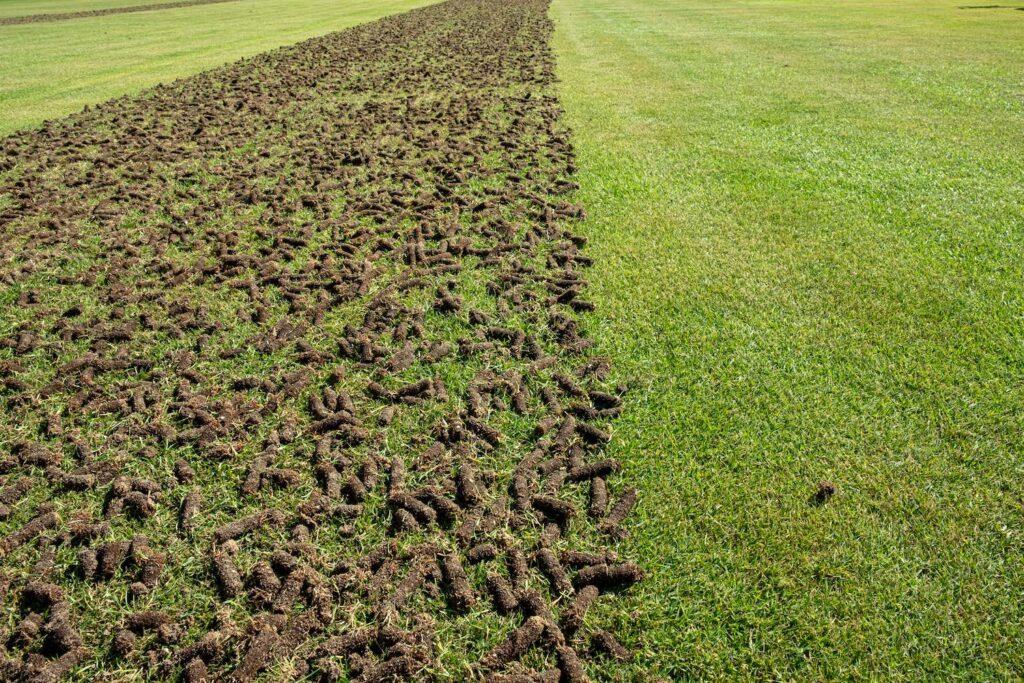
Aerating literally means “bringing air into the ground”. We do this by removing tiny tubes of soil to create air pockets that allow air, light, water, and food to penetrate into the earth. This promotes root growth, strengthening the plant and improving the look of your turf.
What causes compacted soil?
Compacted soil occurs naturally through regular, everyday use of your lawn. The biggest culprits can be:
- Garden furniture
- Play equipment, such as goalposts and basketball nets
- The weight of your lawnmower (if you mow regularly (you should!))
- Walkways through the lawn
Walkways?
Yes. Have you ever noticed that you take exactly the same path from one end of your lawn to the other? If you’re walking from your back door to your garden shed, for example, we’d bet you 10p that you make precisely the same journey every time (we haven’t shaken on it, though!).
Wait until the next snow. Then walk to the shed. Do it without thinking, and you’ll always follow the same route – made more evident from the path you create in the snow.
Or look at the route your pet takes to reach the back of the garden – they’ll likely use the same “path” every time.
Well-trodden paths help compact the soil, which means that there’s probably areas of your lawn that are heavily compacted and parts that are less affected.
Either way, it’s wise to aerate the entire lawn.
The benefits of aerating your soil

Aeration is a temporary process, so aerate periodically. The diagram below shows the benefits of aeration:
Compacted soil cause shallow roots in grass plants. When you make holes in the soil’s surface, air, water, and light reach the roots, encouraging deeper penetration into the earth.
Over time, these aeration holes close, but your grass plants will be healthier because deeper roots improve resistance to drought and disease.
Healthy soil is composed of:
- 50% pores and air pockets
- 50% solid soil particles
Compacted soil loses its pores and air pockets, so aeration helps restore this balance.
Clay soil has smaller pores and restricted airflow, so regular aeration is necessary to improve the soil structure. Sandy soils don’t compact as easily as clay soils, but they still require aeration for optimal health.
Aeration for oxygen
Aeration helps oxygen reach down into the earth. The more oxygen, the more healthy the lawn. Without oxygen, your lawn will die.
If your grass has turned brown, there’s a chance that the oxygen/carbon dioxide levels within your soil have lost their natural balance. Compacted soil holds onto its carbon dioxide, produced as a natural result of photosynthesis – so aerating helps restore that balance.
Aeration for sunlight
Roots, of course, grow underground – but that doesn’t mean that they don’t benefit from some exposure to the sunlight.
Sunlight penetrates porous soil, and plants with relatively shallow roots, like grass plants, detect the sunlight and make use of it to encourage growth. Plant roots have photoreceptors called phytochromes that receive light transmitted from the leaves, but some light penetrates the surface topsoil.
Roots (usually) naturally grow AWAY from the sunlight. So, if you aerate your soil, sunlight reaches the roots through the natural pores in the soil. This encourages the roots to burrow down into the ground, making the root system deeper.
Aeration for irrigation
Water that penetrates deep into the soil encourages deeper roots. And water is an excellent carrier for nutrients – aeration helps maximise the effect of fertilisers.
And if you’re sowing new seed, aeration helps the soil absorb nutrients to boost the likelihood of germination.
So, if you’re wondering, “is aerating your lawn worth it?” hopefully, we’ve convinced you that it’s an essential lawn care task for beautiful lawns!
When should I aerate my lawn?

It’s best to aerate your lawn during its peak growing season. That way, it will recover quickly. Early spring or the beginning of autumn are the best times – just avoid the frost.
Most lawns experience their heaviest battering during the summer while we’re enjoying barbeques and the kids are playing ball games on the grass. Aeration stresses your grass plants, so it’s best to leave it to periods during the year when they’re freer to recover.
Be careful if aerating during the winter – frost will kill the roots if they’re exposed. Aerate at least four weeks before frost is due.
TIP: Keep an eye on the weather forecast and aerate before rain. Then you don’t need to water!
Does aeration actually work?
Well, we’d be wasting our time writing an article about it if it didn’t! 😉
Aeration is one of the lighter lawn care tasks in terms of effort, but it definitely works.
There are liquid aeration products available, which you simply water onto your lawn. But the verdict is still out – most experts refute the claim that liquid aerator products alleviate compaction by breaking down dense soil.
Most experts consider the “core” aeration method the superior approach – and that’s the approach we’re going to be exploring.
How often should I aerate my lawn?
Clay soils become compacted more quickly, so it’s a good idea to aerate once a year.
Sandy soil closes up more slowly, so biannually is usually sufficient. However, you might only need to aerate sections of sandy soil – mainly the areas of most heavy use.
The best advice we can give is: look at your grass. If a moss or thatch layer has developed on the soil surface, it will prevent water penetration. In that case, aeration or scarification is needed.
What is the best way to aerate a lawn?
The verdict is out regarding the efficacy of liquid aerator. At any rate, why add chemicals to your soil when you don’t really need to?
For small or medium-sized lawns, manual aeration is the perfect option. For more extensive lawns, you might consider opting for a mechanical approach.
Spike roller
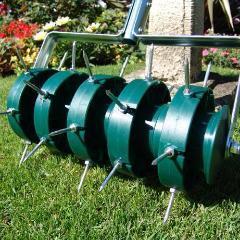
A manual spike roller makes aeration quick and easy. This approach creates very little mess or aesthetic damage to your lawn’s surface.
As you push the roller across the lawn, the spikes (a bit like nails) puncture holes in the soil’s surface, creating those essential little air pockets. Spiking creates smaller holes than a hollow tine aerator, so you may have to repeat the process a couple of times.
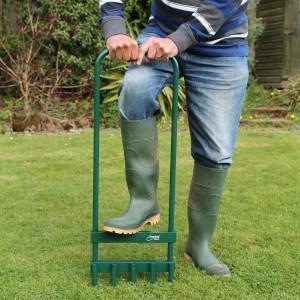
If your soil is very compacted, a spike roller might not do the job – you might be better with a machine.
Aeration sandals
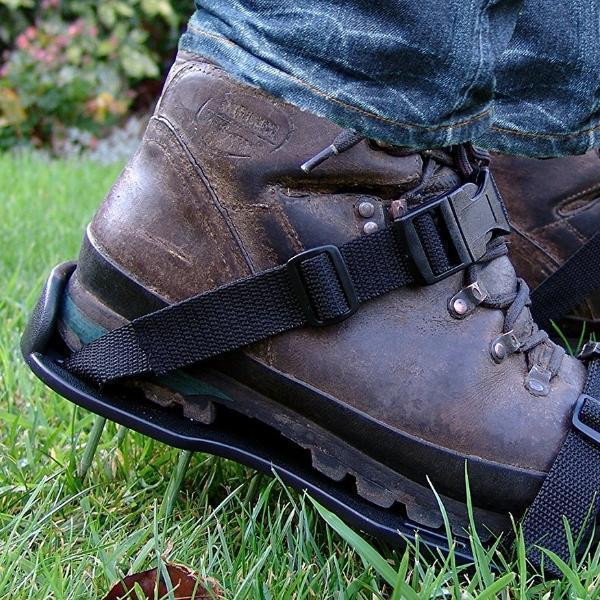
OK, you’re unlikely to see aeration sandals on the catwalk during London Fashion Week, but they’re an easy way to aerate smaller lawns.
Aeration sandals have spikes attached to the underside of the sole and strap onto your usual gardening footwear. Walk around your lawn a couple of times wearing these rather dashing sandals, and the spikes sink into the soil, creating air pockets.
Simple, cheap, and barely any effort. And, dare I say it: fun!
Manually aerate with a garden fork
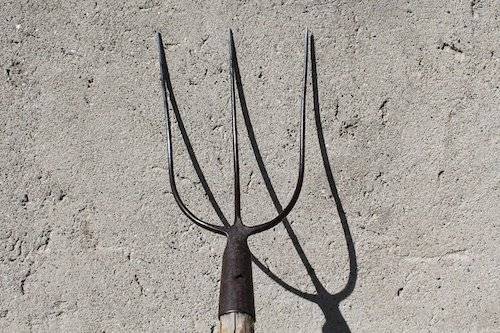
This approach requires a little more effort, but it’s still one of the lighter garden tasks.
If you have a garden fork that’s gathering dust at the back of the shed, it’s time to dust it off. Sink the tines of the fork multiple times into your soil.
- Insert the fork into the ground, keeping the tines as straight as possible.
- Apply pressure so that the tines sink around 10-15cm into the earth. Gently move the fork back and forth to make the holes slightly bigger.
- Repeat this action every inch or so over the surface of your soil.
Fork aeration is time-consuming, so it’s perfect if you’re aerating small compacted sections of your lawn – where the kids have been in goal, for example.
But for larger lawns, save yourself some time and use a roller or a machine.
Aeration machine
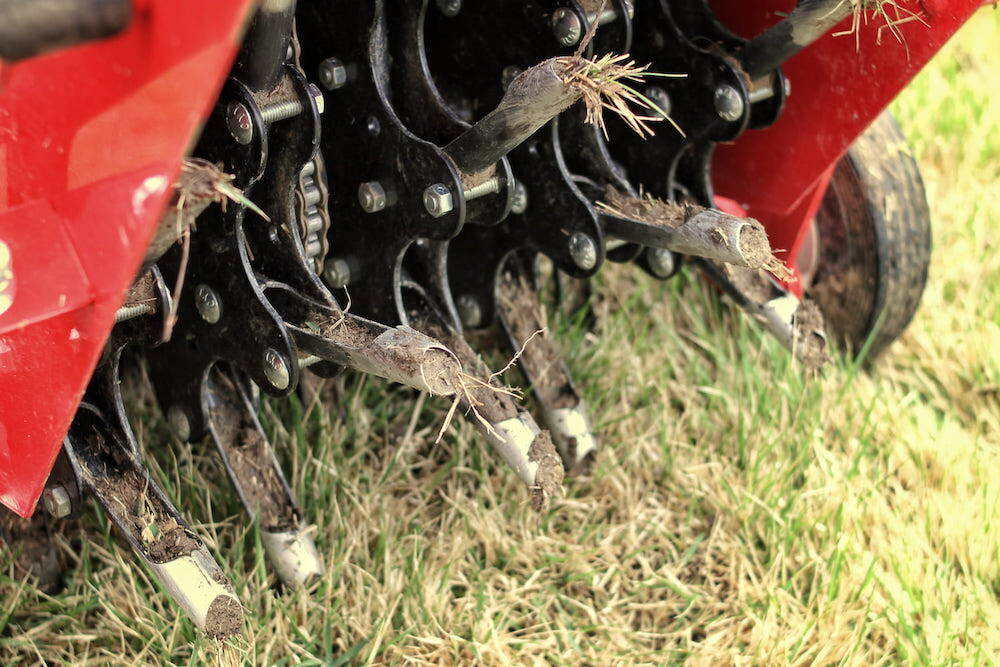
Ready for the big guns? If you have a large lawn or your soil is particularly compacted, an aerator machine is your best bet.
An aerator machine looks similar to an electric lawnmower or scarifier. Equipped with a petrol engine, aerator machines are effortless to use – literally gliding along your lawn’s surface.
Aerator machines use hollow tines that resemble an apple corer (hence the term “core aeration”) rather than a spike. The hollow tines create larger holes in the soil – around 1cm in diameter and 10cm deep into the ground – creating a longer-lasting soil aeration.
Aeration machines can be expensive, but you should be able to hire one.
TIP – Plan aeration with your neighbours and share the rental cost!
How deep into the soil do I need to go for effective aeration?
Aim for 10-15cm in depth for adequate aeration. If you’re using a spiked roller or aeration sandals, ensure that the entire spike sinks into the earth.
Can I aerate a new lawn?
Aerating stimulates deeper roots, sure, but it’s not a good idea to aerate a brand new lawn.
Wait until your grass plants have established a deep root system – so wait until year two before you aerate a new lawn for the first time.
Is aerating the same as scarifying?
Short answer: no. But there are similarities.
Aerating with hollow tines can affect the immediate look of your lawn – it may look a little holey afterwards. But scarifying is the next level of lawn care tasks – your lawn looks like it’s been chewed up by an enthusiastic mole after scarification.
However, your lawn recovers quickly if you do it when the grass is growing well – in early spring or autumn.
For more details about scarifications, check out this article.
What do you do after you aerate your lawn?
Your lawn will need a bit of a tidy-up after aerating, depending on the tool you’ve used. Spike aerating shouldn’t leave that much aesthetic damage, so tidying up is minimal.
But if you’ve used a mechanical solution, you’ll be left with a bit of a messy lawn surface.
Clean up the mess
Hollow tine aeration leaves tubular dints of grass and soil on the lawn’s surface. Some people leave those to dissolve back into the earth, but they look a little unsightly for a while. So, remove any dints with a rake if you want to tidy up your lawn’s surface.
Top dress the soil
Aeration leaves little holes in the soil. Add some well-rotted compost or organic fertiliser, which drops down into the holes. It’s an excellent opportunity to refresh the earth.
If you aerate in the soil, top dress your grass with a high-potassium autumn fertiliser, strengthening the turf and preparing your lawn for overwintering.
Sow bare spots
If you have bald spots around your lawn, post-aeration is a great time to overseed. Germination should be nice and prompt because the soil will receive the air, light, and nutrients it needs to promote faster growth.
Should I mow before aerating?
Quick answer: yes.
What is the best way to aerate your lawn?
Follow our step-by-step guide to aerating your lawn for the best results:
- Mow your grass as short as possible. However, never cut more than a ⅓ of the grass blade’s length to avoid stressing the plants.
- Aerate your lawn vertically and horizontally.
- Clean your tools, removing any lodged-in turf. You’ll thank yourself next time you aerate.
- Tidy up any detritus.
- Fill the gaps with a fertiliser or well-rotted compost to help nourish the soil.
How much does it cost to aerate a lawn?

Aeration is a reasonably simple procedure. The only special equipment you need is the aerator tool.
If you’re using a spike system – a roller or sandals – the initial investment is low: around £50 at the very most. Remember, look after your garden tools, and they’ll last for many years.
If you’re looking at hiring a mechanical aerator, it’s likely to cost around £100 for a weekend. Remember, plan your aerating with your neighbours and share the hire costs.
You could, of course, hire someone to aerate your lawn for you. But where’s the fun in that?
Are you ready to get aerating? Or do you have more questions?
We love hearing from you. If you have any further questions about aerating (or anything else lawn-related), get in touch, and we’ll gladly help!
Thanks for reading!
Leave a comment
Your answer will be displayed on the site and the interested party will be notified by email.
Leave a comment
Have a question or want to share your experience? Leave us a comment.
Read more
The best tips and tricks for a lush green lawn
 Scarifying Kit
All products after scarifying | Quickly restores the lawn after scarifying | Outsmart weeds quickly with the use of this kit
From: € 39.99
Scarifying Kit
All products after scarifying | Quickly restores the lawn after scarifying | Outsmart weeds quickly with the use of this kit
From: € 39.99
 Spring Lawn Care Kit
MOOWY’s choice for the spring | Quick recovery of your lawn after winter | A strong lawn prevents weeds
From: € 25.99
Spring Lawn Care Kit
MOOWY’s choice for the spring | Quick recovery of your lawn after winter | A strong lawn prevents weeds
From: € 25.99
 Long Lasting Lawn Fertiliser
Effective for 90 days | See results in 14 days! | Suitable for all types of grass and soil
From: € 13.99
Long Lasting Lawn Fertiliser
Effective for 90 days | See results in 14 days! | Suitable for all types of grass and soil
From: € 13.99
Do you want a lawn calendar?
🌱 All important maintenance moments for your lawn during the year. Leave your email and we will send you the lawn calendar for free.
Enter your email
Receive the lawn calendar in the mail
Enjoy a green lawn all year round!




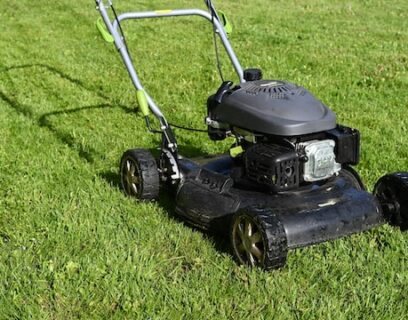
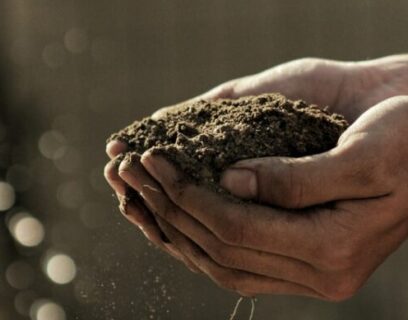
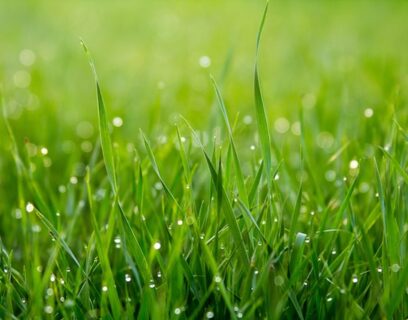





Comments (0)
There are no comments yet. Well then, what are you waiting for to
Be the first to write your comment!inaugurate this pretty page?
Do you have some comments?